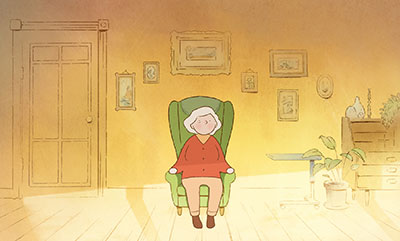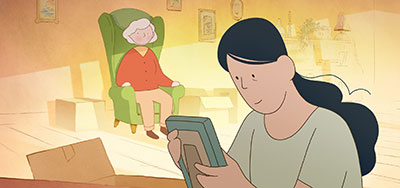
Double Your Impact for the Holidays
Double Your Impact for the Holidays
Your urgently needed year-end gift can go twice as far to provide care and support and accelerate Alzheimer's research this holiday season — and all year long. Show your giving spirit today during this 2x Match Challenge.
Donate NowThe Oscar-nominated animated short film “Late Afternoon” follows Emily, who struggles connecting her past with her present. As she delves in and out of her memories and makes connections to her present-day life, she sits in a room as a woman named Kate, who she doesn’t recognize, serves her afternoon tea.
Written and directed by Louise Bagnall and produced by Nuria González Blanco, the film tells the story of a woman with dementia who is forgetting her past … but who is able to leap into some of her most vivid, special memories. We spoke with Louise about how the film came to be.
Congratulations on the Oscar nomination for Animated Short Film!
Thank you. It honestly wasn’t like anything I’ve ever experienced before. It was absolutely mad, and amazing knowing that there were dozens of people who worked on the film celebrating along with Nuria and I. We are so busy with different events leading up the awards ceremony … I am going to have to get out of my everyday hoodies and find a dress to wear!
How did the idea for the film come about?
 I come up with most of my ideas through my sketchbook. I have original drawings of characters and then begin thinking about their lives, sketching out potential ideas. I gradually got to the place where I decided that I wanted to show a woman’s inner life unfolding on the screen.
I come up with most of my ideas through my sketchbook. I have original drawings of characters and then begin thinking about their lives, sketching out potential ideas. I gradually got to the place where I decided that I wanted to show a woman’s inner life unfolding on the screen.
The character of Emily was inspired by my grandmothers; neither had dementia, but both had memory loss issues as they grew older. When I was a child, I was very close with both of them, but I simply saw them as sweet grannies who would sneak me biscuits, or stuff money in my hands. I didn’t think about what their lives were like before becoming my grandparents.
They both passed away before I became an adult myself, and I wanted to tell the story of an older woman looking back at her memories as a way to honor them both. I wanted to think about the sum of their lives and celebrate who they were, from their time as young girls to becoming grown women. I felt a real push to explore this onscreen.
What were the challenges of telling a story that bounces between present-day and Emily’s memories?
 I wanted to keep the story grounded, connected to a reality, but I also wanted the viewers to go on the journey with Emily. We wanted to include memories that were evocative but also not too nailed down. Memories, after all, aren’t always chronological. And memories, even at the best of times, aren’t perfect. Memory is about how you felt about something, like a song, which becomes heightened by your personal experience of it.
I wanted to keep the story grounded, connected to a reality, but I also wanted the viewers to go on the journey with Emily. We wanted to include memories that were evocative but also not too nailed down. Memories, after all, aren’t always chronological. And memories, even at the best of times, aren’t perfect. Memory is about how you felt about something, like a song, which becomes heightened by your personal experience of it.
We landed on choosing memories that give the viewer an understanding of who Emily was, from her playing on the beach as a young girl in Ireland to becoming a wife and mother, watching her own daughter play on that same beach. I enjoyed the challenge of that. And I’m really happy with how it all came together.
The film truly comes alive through Emily’s memories. When we dive into her memories, they become alive and dynamic, with a flow and sense of momentum, while also being fleeting.
How did color help differentiate the past from the present?
We approached each color palette very differently. In the present day, Emily is in a room that is warm. The palette was based in yellows, the details of the room are simple, with very few elements colored in. We didn’t want it to seem cold or sad, or to suggest that memories are an escape for her, but we wanted to make it very different from what happens when we delve into a memory.
 I remember my grannies talking about their ‘Sunday best’ coats, which is why I chose a bright red for Emily’s childhood coat. When Emily fully experiences her memories, there is a lot of open space, with the camera moving around. You feel happy and free, and the colors become very vivid, highlighting the distinct memories of our character.
I remember my grannies talking about their ‘Sunday best’ coats, which is why I chose a bright red for Emily’s childhood coat. When Emily fully experiences her memories, there is a lot of open space, with the camera moving around. You feel happy and free, and the colors become very vivid, highlighting the distinct memories of our character.
These two places – present day and Emily’s past – allow the viewers to see two sides of her, and the colors were a useful thread for the audience to follow Emily through her subconscious stage as a young girl back to the present day. We wanted viewers to connect this young girl vigorously playing to the older woman sitting in her chair being served tea.
 As the memories become more complicated and we see more of Emily’s life, we start to overlap the color palette, bringing the greens and blues into present day, indicating that Emily’s memories can be overwhelming, but also beautiful. The overlap of colors helps drive home the intense happy feelings at the end of the film.
As the memories become more complicated and we see more of Emily’s life, we start to overlap the color palette, bringing the greens and blues into present day, indicating that Emily’s memories can be overwhelming, but also beautiful. The overlap of colors helps drive home the intense happy feelings at the end of the film.
The bittersweet ending involves Emily realizing that the present-day character of Kate is a very important part of her life story. Why did you decide to end the film this way?
It wasn’t always a part of the story! It was something I really had to think about. I didn’t want the film to have a hopeless ending, but I didn’t want to imply that everything was going to be fine, either. Emily isn’t getting better. She can no longer remember who people in her life are, although she has moments of clarity.
 The moment Emily connects a past memory of Kate to the present is magical. I worked very carefully on the dialogue between the characters, and the hug they share is a release of emotion … so joyful for Emily. But then the final shot of the film is the water washing away a stick on the beach, partially to give the audience a chance to contemplate what they’ve just seen but also to show that part of Emily is washing away. Early in the film, she is a young girl scrawling her name into the sand on the beach with a stick. And now Emily’s memories are fading; no one moment lasts forever. The balance of those two moments is one piece of the film that I gave the most consideration.
The moment Emily connects a past memory of Kate to the present is magical. I worked very carefully on the dialogue between the characters, and the hug they share is a release of emotion … so joyful for Emily. But then the final shot of the film is the water washing away a stick on the beach, partially to give the audience a chance to contemplate what they’ve just seen but also to show that part of Emily is washing away. Early in the film, she is a young girl scrawling her name into the sand on the beach with a stick. And now Emily’s memories are fading; no one moment lasts forever. The balance of those two moments is one piece of the film that I gave the most consideration.
What do you want people affected by Alzheimer’s and dementia to take away from the film?
Our goal was to show a different point of view, allowing viewers to see Emily’s struggle to connect her present with her past, through her eyes.
I think it’s important to let people with dementia be who they are: let him or her have the best days possible without pushing them to remember the things that they may not be able to.
I also think that caregivers need opportunities to talk about their experiences and express their feelings. A lot of people at screenings of the film have talked to me about family members or close friends affected by dementia, and they just want to be able to talk about it openly.
Nuria and I are so pleased to have reached a global audience by highlighting a disease that any person of any culture can be affected by. My team and I hope “Late Afternoon” opens up more lines of communication surrounding Alzheimer’s and dementia.
“Late Afternoon” comes from Cartoon Saloon studio, based in Ireland. The film is nominated in the Animated Short Film category at this year’s Academy Awards, which will air on Sunday, February 24.
Watch the film's trailer below and see if the film is playing in your area.
Film photos and video courtesy of: Cartoon Saloon
Photo of Louise (left) and Nuria courtesy of: Matthew Thompson

The first survivor of Alzheimer's is out there, but we won't get there without you.
Donate Now
Learn how Alzheimer’s disease affects the brain.
Take the Brain Tour
